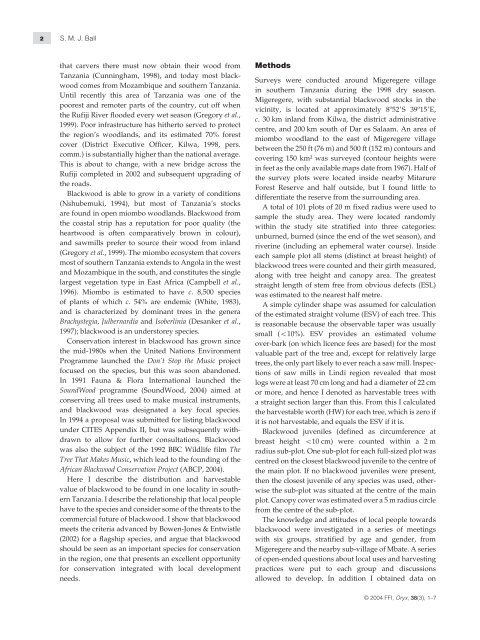Stocks and exploitation of East African blackwood - The Mpingo ...
Stocks and exploitation of East African blackwood - The Mpingo ...
Stocks and exploitation of East African blackwood - The Mpingo ...
You also want an ePaper? Increase the reach of your titles
YUMPU automatically turns print PDFs into web optimized ePapers that Google loves.
2 S. M. J. Ball<br />
that carvers there must now obtain their wood from<br />
Tanzania (Cunningham, 1998), <strong>and</strong> today most <strong>blackwood</strong><br />
comes from Mozambique <strong>and</strong> southern Tanzania.<br />
Until recently this area <strong>of</strong> Tanzania was one <strong>of</strong> the<br />
poorest <strong>and</strong> remoter parts <strong>of</strong> the country, cut <strong>of</strong>f when<br />
the Rufiji River flooded every wet season (Gregory et al.,<br />
1999). Poor infrastructure has hitherto served to protect<br />
the region’s woodl<strong>and</strong>s, <strong>and</strong> its estimated 70% forest<br />
cover (District Executive Officer, Kilwa, 1998, pers.<br />
comm.) is substantially higher than the national average.<br />
This is about to change, with a new bridge across the<br />
Rufiji completed in 2002 <strong>and</strong> subsequent upgrading <strong>of</strong><br />
the roads.<br />
Blackwood is able to grow in a variety <strong>of</strong> conditions<br />
(Nshubemuki, 1994), but most <strong>of</strong> Tanzania’s stocks<br />
are found in open miombo woodl<strong>and</strong>s. Blackwood from<br />
the coastal strip has a reputation for poor quality (the<br />
heartwood is <strong>of</strong>ten comparatively brown in colour),<br />
<strong>and</strong> sawmills prefer to source their wood from inl<strong>and</strong><br />
(Gregory et al., 1999). <strong>The</strong> miombo ecosystem that covers<br />
most <strong>of</strong> southern Tanzania extends to Angola in the west<br />
<strong>and</strong> Mozambique in the south, <strong>and</strong> constitutes the single<br />
largest vegetation type in <strong>East</strong> Africa (Campbell et al.,<br />
1996). Miombo is estimated to have c. 8,500 species<br />
<strong>of</strong> plants <strong>of</strong> which c. 54% are endemic (White, 1983),<br />
<strong>and</strong> is characterized by dominant trees in the genera<br />
Brachystegia, Julbernardia <strong>and</strong> Isoberlinia (Desanker et al.,<br />
1997); <strong>blackwood</strong> is an understorey species.<br />
Conservation interest in <strong>blackwood</strong> has grown since<br />
the mid-1980s when the United Nations Environment<br />
Programme launched the Don’t Stop the Music project<br />
focused on the species, but this was soon ab<strong>and</strong>oned.<br />
In 1991 Fauna & Flora International launched the<br />
SoundWood programme (SoundWood, 2004) aimed at<br />
conserving all trees used to make musical instruments,<br />
<strong>and</strong> <strong>blackwood</strong> was designated a key focal species.<br />
In 1994 a proposal was submitted for listing <strong>blackwood</strong><br />
under CITES Appendix II, but was subsequently withdrawn<br />
to allow for further consultations. Blackwood<br />
was also the subject <strong>of</strong> the 1992 BBC Wildlife film <strong>The</strong><br />
Tree That Makes Music, which lead to the founding <strong>of</strong> the<br />
<strong>African</strong> Blackwood Conservation Project (ABCP, 2004).<br />
Here I describe the distribution <strong>and</strong> harvestable<br />
value <strong>of</strong> <strong>blackwood</strong> to be found in one locality in southern<br />
Tanzania. I describe the relationship that local people<br />
have to the species <strong>and</strong> consider some <strong>of</strong> the threats to the<br />
commercial future <strong>of</strong> <strong>blackwood</strong>. I show that <strong>blackwood</strong><br />
meets the criteria advanced by Bowen-Jones & Entwistle<br />
(2002) for a flagship species, <strong>and</strong> argue that <strong>blackwood</strong><br />
should be seen as an important species for conservation<br />
in the region, one that presents an excellent opportunity<br />
for conservation integrated with local development<br />
needs.<br />
Methods<br />
Surveys were conducted around Migeregere village<br />
in southern Tanzania during the 1998 dry season.<br />
Migeregere, with substantial <strong>blackwood</strong> stocks in the<br />
vicinity, is located at approximately 8º52S 39º15E,<br />
c. 30 km inl<strong>and</strong> from Kilwa, the district administrative<br />
centre, <strong>and</strong> 200 km south <strong>of</strong> Dar es Salaam. An area <strong>of</strong><br />
miombo woodl<strong>and</strong> to the east <strong>of</strong> Migeregere village<br />
between the 250 ft (76 m) <strong>and</strong> 500 ft (152 m) contours <strong>and</strong><br />
covering 150 km² was surveyed (contour heights were<br />
in feet as the only available maps date from 1967). Half <strong>of</strong><br />
the survey plots were located inside nearby Mitarure<br />
Forest Reserve <strong>and</strong> half outside, but I found little to<br />
differentiate the reserve from the surrounding area.<br />
A total <strong>of</strong> 101 plots <strong>of</strong> 20 m fixed radius were used to<br />
sample the study area. <strong>The</strong>y were located r<strong>and</strong>omly<br />
within the study site stratified into three categories:<br />
unburned, burned (since the end <strong>of</strong> the wet season), <strong>and</strong><br />
riverine (including an ephemeral water course). Inside<br />
each sample plot all stems (distinct at breast height) <strong>of</strong><br />
<strong>blackwood</strong> trees were counted <strong>and</strong> their girth measured,<br />
along with tree height <strong>and</strong> canopy area. <strong>The</strong> greatest<br />
straight length <strong>of</strong> stem free from obvious defects (ESL)<br />
was estimated to the nearest half metre.<br />
A simple cylinder shape was assumed for calculation<br />
<strong>of</strong> the estimated straight volume (ESV) <strong>of</strong> each tree. This<br />
is reasonable because the observable taper was usually<br />
small (
















